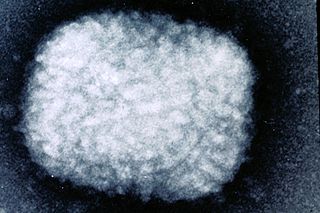Related Research Articles

Erythromelalgia or Mitchell's disease, is a rare vascular peripheral pain disorder in which blood vessels, usually in the lower extremities or hands, are episodically blocked, then become hyperemic and inflamed. There is severe burning pain and skin redness. The attacks are periodic and are commonly triggered by heat, pressure, mild activity, exertion, insomnia or stress. Erythromelalgia may occur either as a primary or secondary disorder. Secondary erythromelalgia can result from small fiber peripheral neuropathy of any cause, polycythemia vera, essential thrombocytosis, hypercholesterolemia, mushroom or mercury poisoning, and some autoimmune disorders. Primary erythromelalgia is caused by mutation of the voltage-gated sodium channel α-subunit gene SCN9A.

Poxviridae is a family of viruses. Humans, vertebrates, and arthropods serve as natural hosts. There are currently 83 species in this family, divided among 22 genera, which are divided into two subfamilies. Diseases associated with this family include smallpox.
Ribeiroia is a genus of trematode parasites that sequentially infect freshwater snails in the family Planorbidae as first intermediate hosts, fish and larval amphibians as second intermediate hosts, and birds and mammals as definitive hosts. In North America, infection by Ribeiroia has been linked to amphibians with limb malformations. The connection between parasitic infection and limb malformations has generated questions about (a) whether parasite-induced malformations in amphibians are increasing, and (b) the consequences of such abnormalities for amphibian population conservation.
Orthopoxvirus is a genus of viruses in the family Poxviridae and subfamily Chordopoxvirinae. Vertebrates, including mammals and humans, and arthropods serve as natural hosts. There are 12 species in this genus. Diseases associated with this genus include smallpox, cowpox, horsepox, camelpox, and monkeypox. The most widely known member of the genus is Variola virus, which causes smallpox. It was eradicated globally by 1977, through the use of Vaccinia virus as a vaccine. The most recently described species is the Alaskapox virus, first isolated in 2015.
Immunocontraception is the use of an animal's immune system to prevent it from fertilizing offspring. Contraceptives of this type are not currently available for human use.
Daved H. Fremont is a professor at the Washington University School of Medicine in St. Louis with dual appointments in the Departments of Pathology and Immunology/Biochemistry and Molecular Biophysics. He is currently director of the Computational and Molecular Biophysics Program. Fremont is also a principal investigator in the Center for Structural Genomics of Infectious Disease and his laboratory has deposited structures of proteins from several major human pathogens to the protein data bank (PDB).
Para-swimming classification is a function-based classification system designed to allow for fair competition in disability swimming. The classes are prefixed with "S" for freestyle, butterfly and backstroke events, "SB" for breaststroke and "SM" for individual medley events. Swimmers with physical disabilities are divided into ten classes based on their degree of functional disability: S1, S2, S3, S4, S5, S6, S7, S8, S9 and S10. The lower number indicates a greater degree of impairment. Those with visual impairments are placed in three additional classes: S11, S12 and S13. One more class, S14, is reserved for swimmers with intellectual impairment. A final class, S15, is for athletes with hearing loss.

Orthopedic surgery is the branch of surgery concerned with conditions involving the musculoskeletal system. Orthopedic surgeons use both surgical and nonsurgical means to treat musculoskeletal injuries, sports injuries, degenerative diseases, infections, bone tumours, and congenital limb deformities. Trauma surgery and traumatology is a sub-specialty dealing with the operative management of fractures, major trauma and the multiply-injured patient.
Grapevine virus A (GVA) is a moderately common genetic virus that affects Vitis vinifera and American Vitis grapevine species throughout the world and can be fatal if not treated. Grapevine virus A is in the family Betaflexiviridae and genus Vitivirus. The common name for this virus is grapevine closterovirus. Common symptoms in infected grapevines include stem pitting. Although there is a treatment available to cure infected grapevines, it is not one hundred percent effective, so preventative measures are the best solution to the virus. Every inhabited continent on the globe has had breakouts of grapevine closterovirus due to the complex genetic makeup of the virus. Grapevine virus A has a single-stranded RNA genome, which is similar to that of Grapevine virus B. There are multiple strains of the virus that vary both molecularly and biologically which account for the slightly different symptoms exhibited by infected plants.
Roselyn J. Eisenberg is a professor at The University of Pennsylvania and a member of the University's School of Veterinary Medicine and School of Dental Medicine. The majority of Eisenberg's research is focused on the herpes simplex virus and the poxvirus and how they enter into susceptible cells. She also studies glycoproteins, vaccines, virology and microbiology.
Raccoonpox virus (RCN) is a double-stranded DNA virus and a member of the orthopoxviruses in the family Poxviridae and subfamily Chordopoxvirinae which consists of eight genera: Avipoxvirus, Capripoxvirus, Leporipoxvirus, Molluscipoxvirus, Orthopoxvirus, Parapoxvirus, Suipoxvirus and Yatapoxvirus Vertebrates are the natural host of Chordopoxvirinae subfamily viruses. More specifically, raccoons are the natural hosts of RCN. RCN was isolated in 1961 from the upper respiratory tissues of 2 raccoons in a group of 92 observably healthy raccoons trapped close to Aberdeen, Maryland.
Biotechnology risk is a form of existential risk that could come from biological sources, such as genetically engineered biological agents. The origin of such a high-consequence pathogen could be a deliberate release, an accidental release, or a naturally occurring event.